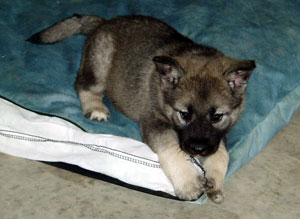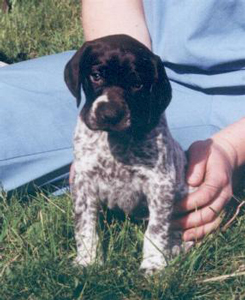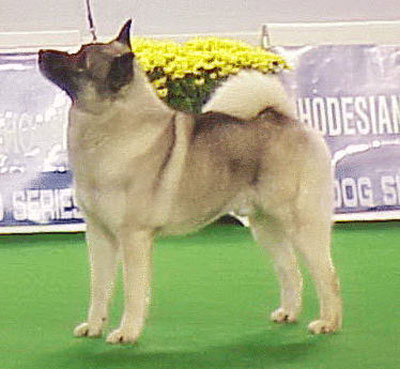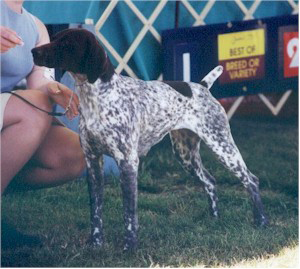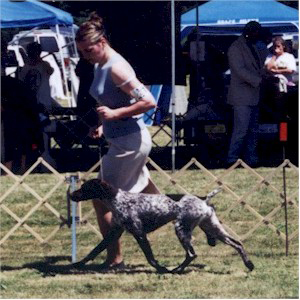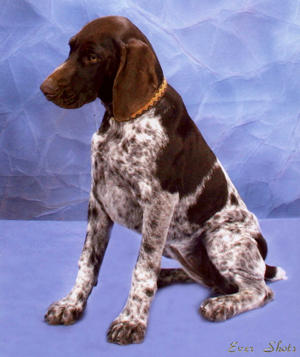History of JANDAL Norwegian Elkhounds & German Shorthaired Pointers
The Norwegian Elkhound
(scroll down for the German Shorthaired Pointer)
In September of 1978, I received a phone call from my fiance, Dale (now my husband); he was very excited about a puppy from a new breed of dog he had just seen--a Norwegian Elkhound. A what? I pulled out the encyclopedia and looked up the breed--medium-sized, double-coated, odorless, healthy, friendly, outgoing, good with children. This breed sounded like fun. I asked Dale where he had seen this puppy. He had come across her in a pet shop where he was making a delivery of two dozen six-week-old hamsters (he raised Teddy Bear hamsters on a commercial scale to put himself through college).
Well, you can guess what happened next: even though we both knew better than to buy a puppy from a pet shop, Dale and this little female Elkhound had fallen in love. "Bjorna" had chosen Dale to be her daddy, and wasn't going to take no for an answer! We were very lucky, though--Bjorna had the classic Elkhound temperament, lived a long and healthy life, and got us thoroughly hooked on Elkhounds for the rest of our lives.
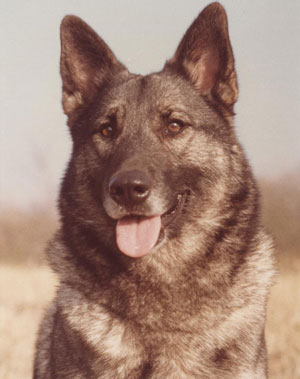
My Bjorna
"Bjorna"
Our first Norwegian Elkhound
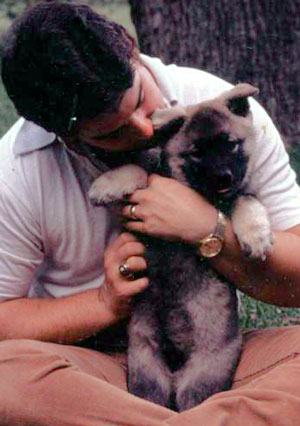
CH Jandal's Ace Of Spades
"Bubba"
at 8 weeks of age
In the summer of 1979, Dale wanted to get Bjorna a buddy to play with. We did not want to deal with raising another puppy due to both of us being in class all day, so we decided to try to find a young adult Elkhound. We noticed an ad in the paper for a 2 year old AKC registered male Elkhound available--the owners were moving from a house with a yard to a townhouse, and had no room for the dog. We decided to go see the dog. What we found was a dangerously overweight, neglected, abused, miserable dog--we couldn't leave him in that environment, so home he went with us. Bear became our project dog--first a bath, to get all the dead hair tufts out of his coat, then a serious diet to trim his weight down. A visit to the veterinarian revealed "Bear" had every form of worms known to man, including heartworms. After his heartworm treatment and recovery period, Bear was a new dog--and a gorgeous Elkhound! As Bear's new body emerged from the obesity, malnourishment, and parasitism, we started seeing his huge bear-like head, his short back, heavy bone, good movement, and overall quality.
On a whim, we decided to see the elkhounds being shown at the Brazos Valley Kennel Club show in November, 1979. Lots of elkhounds were entered, and we were thrilled to see so many in one place together. Several of the exhibitors were very friendly; we shared with them how we had two Elkhounds, one of which seemed to be of high quality. Naturally skeptical, they politely expressed interest in seeing him and assessing him for us. You should have seen their faces when they met Bear! They couldn't believe he was a rescue dog out of a backyard! We were peppered with questions about what his background was, had he been x-rayed yet, had he sired any puppies yet, etc. They told us flatly that it would be a shame for Bear to not be shown to his championship.
Dale and I started attending handling class with Bear, to learn how to show him. We were mentored by several experienced Elkhounders, who taught us how to groom and condition properly for the show ring. Most importantly, we were thoroughly briefed about the genetic diseases Elkhounds were at risk for developing. Bear and Bjorna were screened for hip dysplasia, genetic eye diseases, renal glycosuria, and sebaceous cysts. Unfortunately, Bjorna was found to have hip dysplasia--typical of a pet-bred, pet shop Elkhound puppy. She was subsequently spayed. However, Bear cleared all his genetic screens with flying colors, and was entered in his first AKC show in February of 1980.
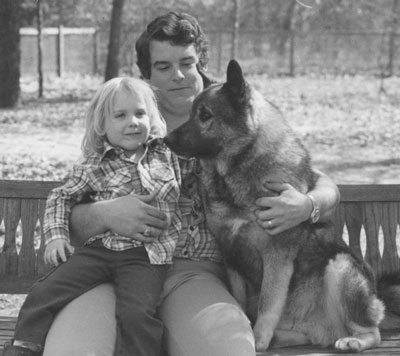
CH Bear Sabastian Viknorski
"Bear"
Our "Cinderella" backyard dog
As they say, the rest is history: Bear, the "Cinderella" backyard dog, completed his
AKC Championship 18 shows later, in January of 1981. Going to the shows, we met many Elkhounds
and their people, and came to a realization: we loved Elkhounds in particular and dogs in general,
we enjoyed showing the elkhounds, and we wanted to get involved in breeding champion-quality
elkhounds. In particular, I wanted to breed and show Elkhounds ethically--all breeding stock
genetically screened, all non-show quality puppies placed on spay/neuter contracts in loving homes.
I started Veterinary School at Texas A & M University in the Fall of 1980; what I was learning
about the devastating emotional, financial, and physical toll genetic diseases levy on dogs and their
owners was startling, to say the least.
We acquired our primary foundation brood bitch
from a prominent breeder in California in April of 1980. Jasmine came from a stellar background,
with many of the breed's all-time top winners in her pedigree, and genetically screened. Jasmine
was already in whelp to one of the top Elkhounds of the day when we bought her; she safely
delivered a litter of 6 in May 1980. Two puppies completed their championships from this litter;
the other 4 were placed in loving homes and spayed/neutered.
We acquired two additional foundation brood bitches over the next 2 years, and
started weaving the genetic "rope" that now stamps our puppies as JANDAL
elkhounds to this day.
The German Shorthaired Pointer
In 1998, a prominent breeder client of mine had an out-of-town family emergency that left her in a severe quandary: she had a champion German Shorthair bitch, bred to a multiple Best In Show winner, due to whelp literally any minute. I volunteered to whelp the litter out for her. She dropped "Sparkle" off with me at my veterinary hospital on her way to the airport. I took Sparkle home with me that afternoon. Sparkle had the first pup about 5 minutes after I got her unloaded and settled in a whelping crate!
I found German Shorthairs to be fascinatingly different from Elkhounds. Elkhounds are very outgoing, bold & energetic, independent to a fault, capable of fast learning but seldom do so, not bed-hogs (they like the cool bathroom tile), and must be on a leash when outside the yard, or they're in the next county. Shorthairs, on the other hand, are more needy, very athletic, fast-learners, dedicated bed-hogs, and have the endearing habit of seldom needing a leash--they just naturally hang around! Once again, we were hooked!
The breeder/client let us buy one of the males from the litter. We christened the pup, "Panzer," and registered him as Brazos River Tank Command.
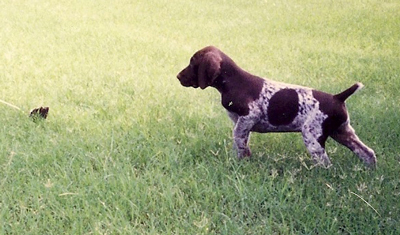
CH Brazos River Tank Command
"Panzer"
On his first point: A quail wing at 6 weeks of age!
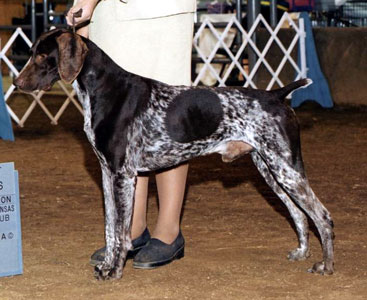
CH Brazos River Tank Command
"Panzer"
Finishing his Conformation Championship in Arkansas
Like Elkhounds, Shorthairs represent an interesting breeding challenge. In Elkhounds, we were trying (very successfully) to combine the classic bold, outgoing, stable Elkhound temperament with classic Elkhound breed type and healthy genetics. Shorthairs were a little different. We required not only a calm, stable, loving temperament, healthy genetics, and beautiful conformation, but we also needed each Shorthair to have a very strong overriding desire to find birds. You who have been around bird dogs know what a dilemma it can be: most of the really good bird dogs are so hyper and over-the-top that you can't live with them--they end up living in a chain link dog run in the back corner of the yard. Bird dogs with calm, livable temperaments tend to be dead-heads in the field, only hunting birds as long as it's easy. We demanded our dog be good at both: easy-to-live-with house dogs that were safe around kids and small pets, plus hell on wheels in the field on birds.
Panzer got his championship without much trouble, and 2 legs towards his Junior Hunter title. We found he was a great house dog, cleared all his genetic tests and had a lot of natural talent for birds, but not much desire--he hunted when it suited him. So, we made the difficult decision to neuter him and find a pet home. However, we were determined to pursue breeding top quality Shorthairs.
Our pursuit of foundation stock to start our breeding quest was very revealing. We heavily researched various kennels and breeding lines, and came to several conclusions. First of all, very few show-bred Shorthairs are hard-driving, efficient bird dogs in the field--their desire to hunt isn't strong enough; they usually have the desirable conformation & temperament, but not the bird drive. Secondly, very few field-bred Shorthairs have calm, stable, livable temperaments or proper conformation; they're bird-finding fools, but many don't even look like a Shorthair, and don't have a proper, trustworthy temperament. Lastly, some Shorthair kennels did their homework on genetic testing (hips, eyes, cardiac, thyroid) and some didn't. However, there are a few show kennels that make sure to test their dogs in the field--this is where the Junior Hunter/Senior Hunter/Master Hunter titles come in. This proves their dogs have at least SOME bird drive. There are also a very few field kennels that pursue a conformation title as well as a field trial title on their dogs. This proves their dogs are correct conformationally as well as have a strong hunting drive. We decided to acquire our foundation stock exclusively from either of these two sources.
We got the opportunity to acquire CH Marvel's Causin' A Riot ("Riley") and her daughter, Braebrook's Let The Games Begin ("Jenna"). Both girls had the hard, stable, outgoing, easy-to-live-with temperament we required, were drop dead gorgeous to look at, and were very birdey in the field. Riley's breeder was a close friend; I knew every one of her dogs had the same requirements we had for our Shorthairs.
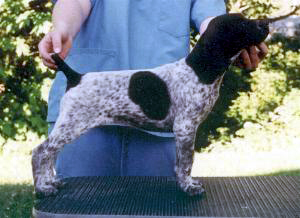 CH Braeburn's Let The Games Begin
CH Braeburn's Let The Games Begin
"Jenna"
Practicing as a puppy
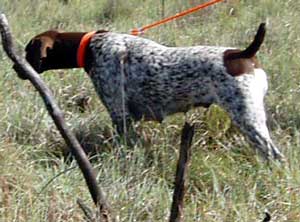
CH Braeburn's Let The Games Begin
"Jenna"
On her first point!
We completed Jenna's championship in short order. We elected to pursue breeding our two girls before getting their hunting titles. Unfortunately, Riley ended up with a very rare form of liver cancer, so she'll never produce another litter. Jenna was successfully put to SBIS CH Crystal's Opening Day MH ("Frank"). They produced a beautiful litter of 1 boy, 5 girls in August 2006. So far, two females from the litter have completed their championships and are multiple group placers, 1 is a specialty winner, 1 has her Junior Hunter, WR CGC and Novice Rally titles, and the boy and an additional female are started on birds. The remaining two pups are in private homes, serving as loving family pets and personal bird dogs.
We were introduced to Jon & Cindy Hann of Perfection Kennels in Kidder, Missouri, by Frank's owner, when it was time to send Jenna's pups off to bird dog school. Jon & Cindy come from the field trial arena, where they have won numerous titles, awards and competitions. However, they also want their dogs to have stable, calm temperaments and correct conformation. Sound familiar? Talk about a meeting of the minds!
Jon & Cindy were gracious enough to sell us a co-ownership in a top prospect of theirs, a young female Shorthair named Karla. In addition, we bred Jenna to Karla's grandfather, DC AFC Odyssey's Perfection MH ("Karl"). Karl is the youngest male Dual Champion in the history of the breed, meaning he got his Conformation Championship and his Field Trial Championship at a younger age than any other GSP male in history. He is also an Amateur Field Trial Champion and a Master Hunter. Karl, simply put, is a bird-finding machine, that cranks it up to the next notch when you go from hunting on foot to hunting on horseback. However, around the house, he's as laid back and easy going as can be, and snores the night away in his pet-parents' bed every night.
We bred Jenna to Karl twice, resulting in a total of 4 males and 7 females. 2 of the boys are being developed as Dual Champion prospects; an additional boy is a top personal gundog. 5 of the girls are already talented bird dogs, with 3 of them being developed as Dual Champion prospects.
With the superior genetics of Jenna and Karla, we anticipate weaving a Shorthair "genetic rope," that will successfully combine gorgeous conformation, calm stable temperament, healthy genetics, and the keen desire to hunt.
The Bottom Line
Every single JANDAL elkhound and shorthair has been genetically screened before being shown, field trialed, hunt tested or used for breeding. Any JANDAL elkhound or shorthair that cleared genetic tests, but produced problems in its offspring, was spayed/neutered along with all its puppies. We have chosen to stay a very small, select kennel. We usually have only 7 or 8 adult elkhounds or shorthairs at any time, so a puppy from one of our litters has to be VERY special, both conformationally and temperamentally, for us to keep it. We keep back only the best puppies as show and field trial prospects, and show only the very best of those. Our kennel has produced 32 champions over the last 29 years.
